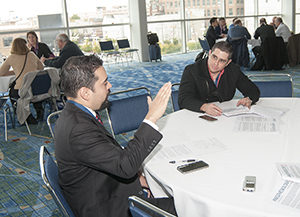
Eduardo E. Galeano, M.D. (left), and Alonzo Hidalgo, M.D., discuss the treatment of subarachnoid hemorrhage during a PBLD Tuesday.
A subarachnoid hemorrhage (SAH) is a life-threatening event that also can cause neurological damage, making quick, effective action vital. Anesthesiologists are at the center of these events in controlling blood pressure and glucose levels that can affect outcomes.
A Tuesday Problem-Based Learning Discussion (PBLD), “Just Another Subarachnoid Hemorrhage? Or Am I Really Up-To-Date on What to Do?” reviewed the latest approaches to the treatment of dangerous intracranial aneurysms.
The PBLD leader, Eduardo E. Galeano, M.D., an anesthesiologist at Montefiore Medical Center, New York, used the case of a 46-year-old female patient to review the latest procedures for treating SAH.
The patient arrived with “the worst headache of her life,” and was eventually diagnosed with a grade 2 SAH. The most common victims of an SAH are women aged 55-85, 25- to 45-year-old men and men older than 85 years.
It is important for the anesthesiologist to become involved with such cases as soon as possible, not when the patient arrives in the operating room, Dr. Galeano said. It also is important to know which drugs to use to sedate the patient and control intracranial pressure so the brain becomes relaxed. ICU or emergency department staffs may not be familiar with the best techniques for controlling pressure.
Ideally, patients with an SAH would be treated within eight hours of the start of the SAH event, but treatment within 24 hours is common, he said.
Another key step is glucose control. Studies show that a glucose level of 129 mg/dl or greater was shown to increase the risk of alterations of consciousness. A glucose level of 152 mg/dl or greater was shown to increase neurologic defects.
Treating a patient with an aneurysm also requires maintenance of hemodynamic control. A study found that a decrease of greater than 50 percent produced poor outcomes and that maintaining a systolic blood pressure of less than 160 mmHg is recommended.
The most common treatments for a patient with a ruptured aneurysm are surgical clipping or endovascular coiling. Studies show the difference in benefits between the two treatments is small. Dr. Galeano said that clips are often used on younger patients because they involve a one-time surgery. Patients treated with endovascular coiling need regular checkups and are more likely to require a second surgery.
Hypothermia may be used, but studies have not determined a protective effect, he said.
After surgery, extubation is usually delayed. A discussion participant, Alonzo Hidalgo, M.D., from Mexico Hospital, San Jose, Costa Rica, said, “We leave it in and wait until they are in the ICU to see the evolution of the patient.”
Return to Archive Index